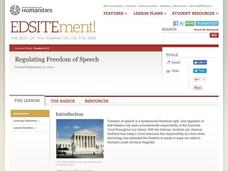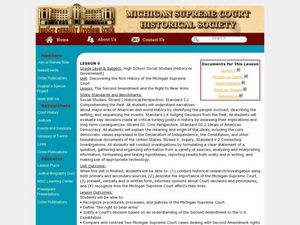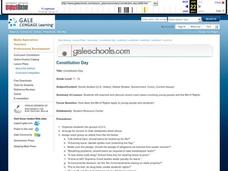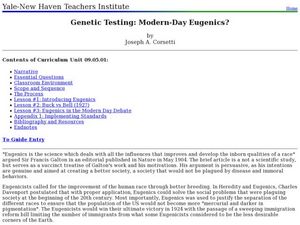Curated OER
Near v. Minnesota
Students discuss what free press means and what it would be like without this right. They read the summary from the Near v. Minnesota case. In groups, they analyze a problem and report to the class.
NYC Department of Records
Citizenship and Elections: The Importance of a Ballot
Approximately 58 prcent of those eligible voted in the 2016 US Presidential election. In an attempt to impress upon learners the importance of voting and voting rights, class members examine primary source documents related to the...
PBS
Ken Burns: Jackie Robinson - A Journey Back to Separate but Equal Conditions
Baseball great Jackie Robinson fought for social justice. His efforts to push for equal access are detailed in an episode from from the Ken Burns: The Jackie Robinson Collection. After viewing the clip, class members engage in a series...
Curated OER
Hazelwood v. Kuhlmeier (1988)
Students explore the concept of student press rights. In this case study lesson, students read excerpts of Hazelwood v. Kuhlmeier. Students then complete the provided worksheet activities and determine whether they agree with the outcome...
Curated OER
Tinker v. Des Moines (1969)
Students explore the concept of symbolic speech. In this case study lesson, students read excerpts of Tinker v. Des Moines. Students then complete the provided worksheet activities and determine whether they agree with the outcome of the...
Curated OER
Regulating Freedom of Speech
Pupils examine the nature and limits of the Constitutional right to freedom of speech. They read and analyze the First Amendment, discuss various case studies, and research and record their own opinion on discussion questions.
Curated OER
Should Homosexuals Have the Right to Laws Protecting Them From Discrimination?
Students explore discrimination issues in America. In this homosexual rights lesson, students listen to their instructor lecture on antidiscrimination laws and gay rights. Students respond to questions about the Romer v. Evans case.
Curated OER
The Second Amendment and the Right to Bear Arms
Young scholars examine procedures and processes of the Michigan Supreme Court. They explain the Second Amendment to others. They compare and contrast two cases dealing with the Second Amendment.
Curated OER
Ex Parte Milligan
Middle schoolers reserach the case of Ex Parte Milligan. They explore the influence of the Supreme Court and the court decisions on the rights and responsibilities of citizens. They read Milligan's letter to Stanton and generate...
Curated OER
Bill of Rights -- Texas v. Johnson, 1989
Students examine the First Amendment of the Bill of Rights. During a visit to the George Bush Presidential Museum, they watch a video about the Texas v. Johnson flag burning case. In groups, they discover the role of the Supreme Court...
Judicial Learning Center
About Federal Judges
Not just anybody can do the job of a federal judge, but according to the United States Constitution just about anybody can be appointed. The lesson outlines the process and requirements for becoming a federal judge, focusing on the...
iCivics
The Road to Civil Rights
Here is a fantastic resource on the civil rights movement! It includes reading materials and worksheets, and particularly highlights major legislation and the role of the judicial branch in the federal government in addressing the...
Curated OER
The People's Right to Know
Students review Supreme Court ruling on the right to know, prior restrain and access to government. They read The Progressive case and hold a moot court to argue the outcome.
Curated OER
Lee Yick: Fighting Racism
Students study the 14th Amendment, then review and analyze a Supreme Court brief. There was much racism exhibited toward the Chinese immigrants by the European Americans; this came in the form of institutional racism and mob violence....
Curated OER
THE JUDICIAL BRANCH
Students create a series of drawings to show the process of how the Supreme Court does its work. The drawings may be in strip cartoon form or a series of separate illustrations.
Curated OER
Right of Privacy: 4th Amendment
Learners are introduced to the 4th Amendment of the Washington state Constitution. In groups, they examine the Constitution of the state of Washington and compare it to the United States Constitution. They role play the role Supreme...
Curated OER
Constitution Day
Students examine and discuss recent court cases involving young people and the Bill of Rights.They use a focus question to create the context for class discussion: How does the Bill of Rights apply to young people and students?
Curated OER
The Constitution and The Bill of Rights
Studnets learn about The Constitution and The Bill of Rights through a series on Internet pages that include such things as the framers, court cases and games.
Curated OER
Oral Arguments Online
Students participate in their own mock oral arguments. They create their own opinions and discuss any opposing opinions. They write their own opinion for a case to end the lesson plan.
Curated OER
Latinos and the Fourteenth Amendment: A Primary Document Activity
Students explore Latinos and the Fourteenth Amendment. In this government and law lesson, students analyze the ruling in Hernandez v. Texas. Students predict how the United States would be different if the court had made an alternated...
Curated OER
Genetic Testing: Modern-Day Eugenics?
Students trace the history of the development of Eugenics. In this social studies lesson, students read and analyze a real life case. They write a paper about what they read.
Civil Rights Movement Veterans
Timeline of Events: 1960’s Civil Rights Movement of St. Augustine, Florida
A timeline can be a powerful learning tool because it reveals a pattern in events. While few would consider St. Augustine, Florida a hotbed of the 1960s Civil Rights Movement, a selection of background information and a timeline of...
Curated OER
Social Studies: Native american Tribal Sovereignty
Pupils examine the issue of tribal sovereignty for Native Americans. Following a mock trial simulation based on the case of Johnson v. McIntosh, they write opinion papers based on the results of the Supreme Court decision in 1823.
Curated OER
Ira Ritter, Et Al., V. Jerry And Ruth Stanton Lesson 2: What Does a Jury Do Anyway?
Students investigate how a jury is chosen, and what the rights and responsibilities of juries are. They examine case studies to determine the role of the jury in both criminal and civil cases.
Other popular searches
- Landmark Supreme Court Cases
- Famous Supreme Court Cases
- Racism Supreme Court Cases
- U.s. Supreme Court Cases
- Supreme Court Cases Poster
- Us Supreme Court Cases

























